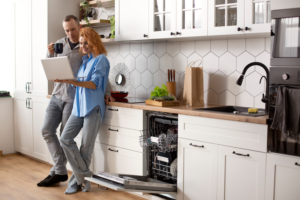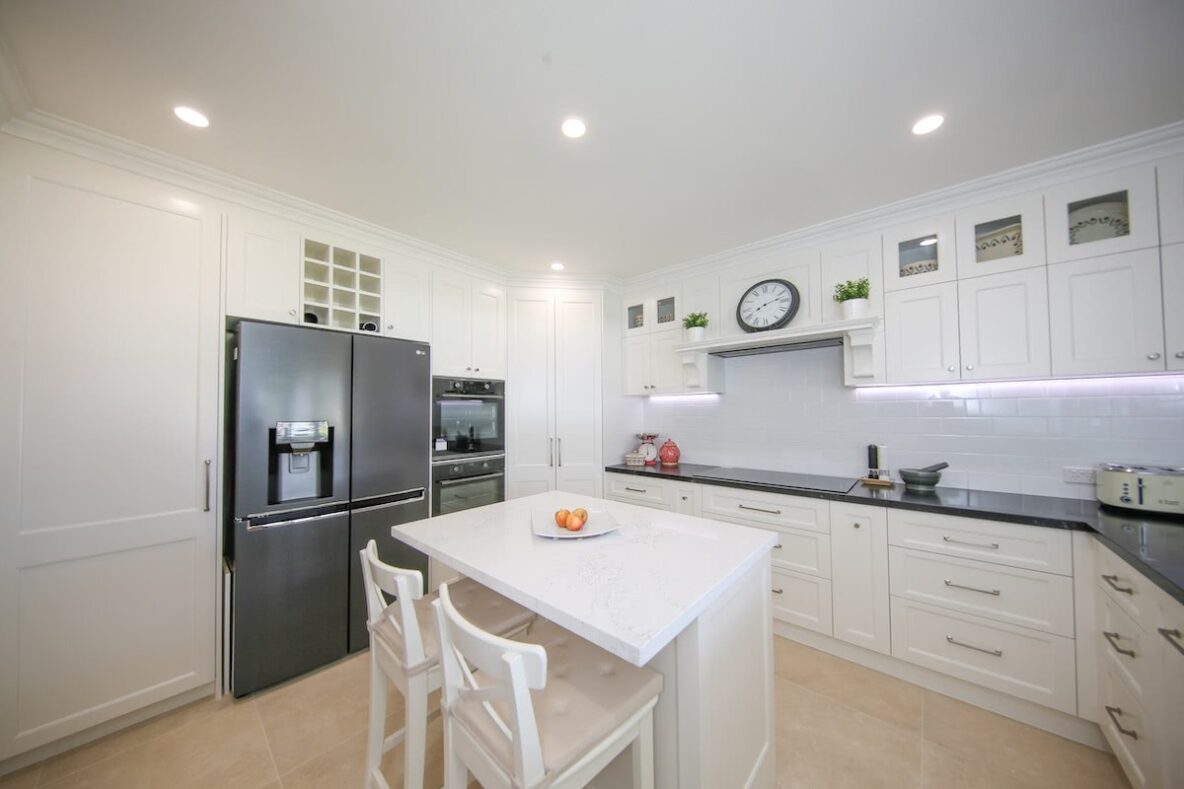A smart kitchen that’s equipped with the latest technology can make preparing and planning meals easier. It can also save you money.
From slashing food waste to cutting the cost of electricity, water and time spent slaving over a hot stove, smart kitchens offer a wide range of benefits and contribute to a more sustainable home.
Read on to find out the best features for a smart kitchen and how to incorporate technology into your kitchen renovation.
4 Key Considerations For a Custom-Built Culinary Haven
A smart kitchen offers convenience, customisation, efficiency, improved organisation and energy savings.
However, with such a wide range of products on the market, it can be difficult to know which elements to incorporate into a kitchen renovation to embrace all that smart kitchens can offer.
Here are the key considerations when it comes to seamlessly blending technology, functionality and aesthetics.

1. Kitchen Layout and Design
The foundation of every good kitchen is intelligent design. A layout that makes your space efficient as well as aesthetically pleasing will consider factors such as workflow (where your drawers are positioned and what they hold, for example), preparation space (are your benchtops close enough to your cooking zone) and the work triangle (with the stove, sink and refrigerator an equal distance from each other).
Kitchen designs are tricky to perfect. Employing a professional will help you optimise the kitchen layout and identify where automation and technology could improve efficiency.
For example, storage solutions such as drawers with built-in sensors and strategically placed smart appliances will ensure the smart components blend seamlessly with the kitchen design.
A professional will also help you consider things you may overlook, such as having drawers at the bottom of your pantry as opposed to shelves and power points within cabinets, so that benchtop appliances can be hidden away.
2. Smart Appliances
From a refrigerator that monitors ingredients and offers recipes via an inbuilt screen to a pressure cooker that can be controlled remotely to have your food ready before you get home, smart kitchen equipment has come a long way in the last few years.
As smart home devices such as Amazon Alexa, Google Home and Apple HomeKit have become more popular and affordable, integration with kitchen technology has followed. Now, you can find almost any kitchen appliance with an internet connection.
Gone are the days when dishwashers with touchscreen operation were high-tech. Now, you can use voice control to request your coffee machine make you a cup before you even get out of bed. These smart home appliances and gadgets don’t just make life easier, they can also optimise power use for greater energy efficiency.
3. Connectivity and Automation
For a truly smart kitchen, connectivity and automation are key. Smart kitchen appliances such as fridges and ovens connected to your home Wi-Fi network can be controlled remotely via a smartphone, and they can communicate with each other to make life more convenient. You might choose to integrate a voice assistant to control your smart devices when you need to find recipes, control task lighting or set timers.
A centralised hub can help you create automation routines and simplify the user experience. Therefore, it’s important to have a reliable Wi-Fi network and good security protocols to protect your kitchen’s smart ecosystem.
Embrace home automation and connectivity by including some of these technologies and never have to press a button or flick a switch again:
- Smart speakers to control music.
- Devices to remotely or automatically switch lights off and on.
- Smart flooring that automatically switches on the heat in cold climates.
- Smart windows or blinds that can be controlled automatically or remotely based on sunlight or temperature.
- Smart locks on doors or smart doorbells for deliveries of groceries or parcels.
- Taps with touchless operation to reduce water usage and improve kitchen hygiene.
- A kitchen app to find nutrition information, a recipe for dinner or create shopping lists that the whole family can add to.
- Smart thermometers and cooking appliances for the convenience of cooking from your smartphone.
4. Budget and Cost Considerations
Adding smart functions and appliances can add to the cost of construction when it comes to kitchen renovation, so be sure to weigh up the value they add to your home and any potential energy savings. Set a realistic budget that not only looks at the cost of installing smart features but also considers any ongoing maintenance.

Make a Smart Move With Easy Living Kitchens
A well-considered, custom-built smart kitchen can enhance your cooking experience and improve the sustainability of your home. From busy professionals to young families and the elderly, a smart kitchen can offer features for all types of families.
However, the key to a successful smart kitchen is one that incorporates devices and technologies that genuinely make life easier for its users and doesn’t just add technology for the sake of it.
Easy Living Kitchens can make your vision come to life with a modern, efficient and connected kitchen that meets your specific needs. As kitchen renovation specialists in Brisbane and surrounds, we’re with you through your custom kitchen renovation every step of the way, from design to manufacture and installation. To learn more about designing a smart kitchen for your home, contact us today on 1300 650 681.

